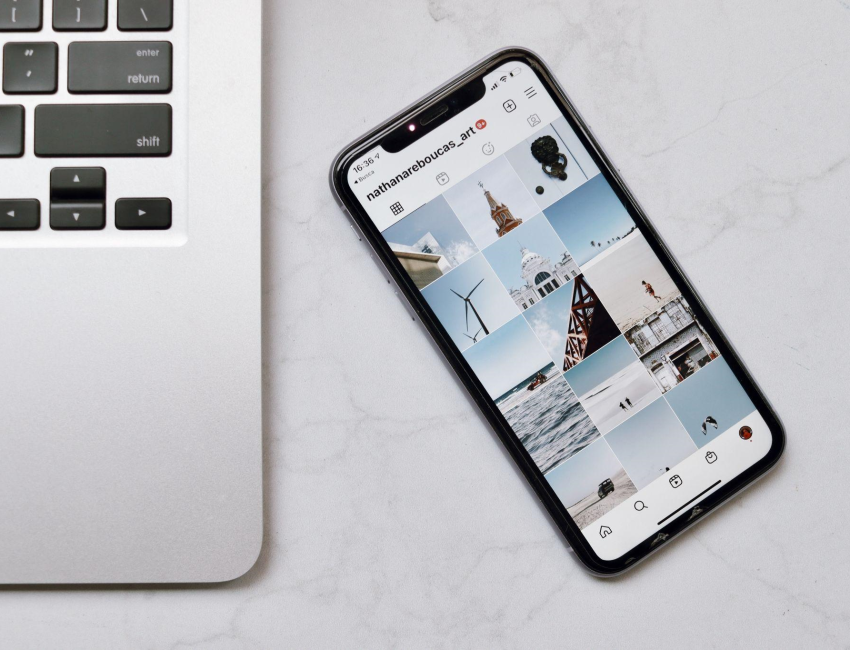We live in a visual world, and we market in a visual landscape. Especially when marketing to younger generations or creative audiences, an Instagram presence is a must. Instagram is a social media platform owned by Meta, the same company that owns Facebook, designed to highlight photos and videos that tell your story.
On the outset, Instagram is an easy platform to use. You need a mobile app, an image, and a video lasting less than 60 minutes. You can create a post, set a filter that changes the lighting and effect of the image, and add up to 30 hashtags where users can find your post. You can also post Instagram stories, which last up to 15 seconds, or choose to “go live.”
On your profile, Instagram posts are shown in the form of a grid of three columns. You can also use this grid to boost your Instagram marketing, by creating a cohesive and visually pleasing theme.
What Is an Instagram Theme?
Take a look at the profiles of those Instagram accounts that you feel best utilize the platform. Chances are when you look at their grid, there’s a running theme. This could be a color scheme or aesthetic, or it could be the subject of the imagery. This is done intentionally, and with dedication, in order to remain consistent. Instagram is all about aesthetics. An Instagram theme is a great way to show off the aesthetic of your brand to your target audience.
What Goes Into an Instagram Theme?
So you want to create an Instagram theme? It requires more thought than you might think. Here are some of the elements that will need to go into your instagram theme.
Content
You can create a checkerboard theme by being deliberate with the order in which you post your content. For instance, many Instagram users alternate between vibrant photography and quotes or screen captures from other websites, usually centered in a plain background. By doing so, your content theme remains checkered every time you post. You can also create stripes by posting certain content on certain days. Consider looking at other instagram themes you like to draw inspiration.
Color
Color is essential to your Instagram theme. This is not to say that your theme should be all one color. In fact, it should be a little more varied. But it’s good to have a color scheme throughout your theme. Try including the color schemes already associated with your brand, or something similar to the theme of your website. Your posts can include pops of a common accent color you use as a through line, or similar background colors.
Want to mix things up further? Consider making a rainbow with a few rows of red, then orange, and so on. Or if you have a couple strong colors in your usual brand aesthetic, you might create horizontal stripes with your theme.
Lighting
Lighting truly can make all the difference when it comes to your Instagram posts. Instagram users like photos that are brightly lit, so that the object of the image can be clearly seen; however, posts made with an artistic mood lighting can still make for a success. One thing you want to avoid is grainy, dimly lit phone pictures.
Many Instagram marketers have their own area or photo box for Instagram photos. Whether you’re taking a picture of a new product or some books that you recently purchased, try to take the picture in the same place to keep the lighting consistent. If you’re taking a picture of outdoor views, just try to make sure the lighting fits with the rest of your theme.
Filter
The filters you use for your Instagram posts will also play into your theme. Filters are overlays that cast your posts in different lighting or accentuate cooler and lighter colors in your images. For instance, Slumber, Crema, and Ludwig all cast the image in warmer tones, while Walden or Nashville bring out the cooler colors in the image. You may also opt to use no filter at all. If you do use filters, make sure that the filter you use fits with your theme.
Consistency
Make sure that your Instagram theme is consistent. Creating one Instagram theme and, then mid-grid, changing to something completely different can be rather jarring. That said, you don’t have to lock yourself into one theme forever. Brands often find reasons to rebrand or change their aesthetic. You may change your theme based on the season or based on certain events. The key is to end each theme with a full grid before starting the next theme.


